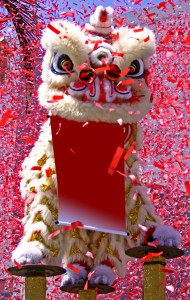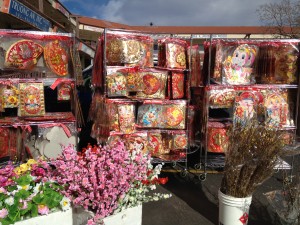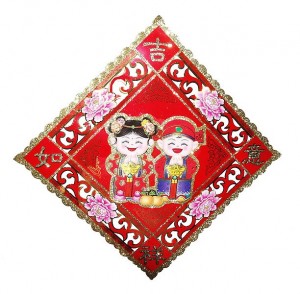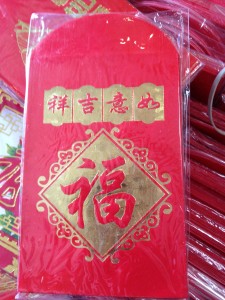春节 Chinese New Year
Information About the Holiday | Common Sights During the Holiday | Festive Activities | Recommended Books, CDs and DVDs
Information About the Holiday (back to top)
Chinese New Year is the most important holiday of the year and spans 14 days, culminating with the Lantern Festival on the 15th day. In both English and Chinese, there are several common names for “Chinese New Year” which include: The Spring Festival 春节 chūnjié, New Year (though this can also mean January 1st) 新年 xīnnián and the Lunar New Year or Agrarian Calendar New Year 农历新年 nónglì xīnnián.
The date of the Chinese New Year is determined by the traditional Chinese calendar which is lunisolar. This means that the holiday falls sometime between January 21st and February 20th on the Gregorian calendar. Chinese years are named according to a sixty year cycle made up of 12 different animals combined with 5 different elements. The animals of the zodiac, known as the 12 birth emblems or 十二生肖 shí’èr shēngxiào, are rat, ox, tiger, rabbit, dragon, snake, horse, sheep, monkey, rooster, dog and pig (boar). The elements of the cycle are fire, water, wood, metal and earth. For a list of Chinese New Year dates and zodiac animals past and future, click here.
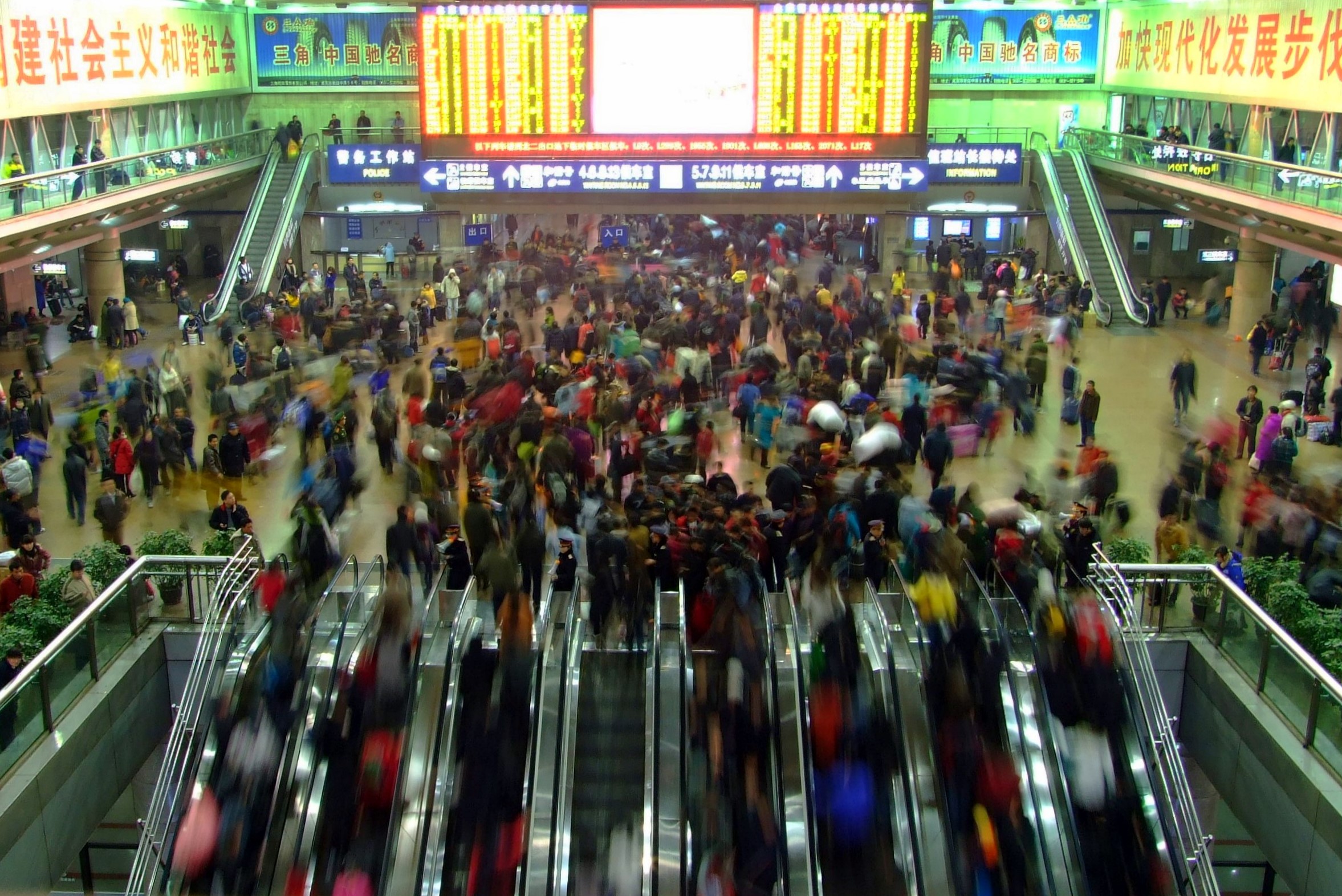
A train station in Beijing during Chinese New Year in 2009. Photo by Charlie Fong (冯成)
Chinese New Year is the number one family holiday and it is an essential time to return home and reconnect with relatives. All of the people traveling across China during Chinese New Year results in the largest migration of people anywhere on the planet. The Chinese New Year holiday is the longest vacation most workers get in a year. For migrant workers, this is often the only time they see their families all year.
In preparation for the big holiday, there is a lot of shopping, cleaning and cooking to do. A popular saying sums of the busy feeling of the days before New Year’s Eve:
“Eat sticky candy on the twenty-third; sweep clean the house on the twenty-fourth; fry up tofu on the twenty-fifth; stew some mutton on the twenty-sixth; kill the rooster on the twenty-seventh; set dough to rise on the twenty-eighth; steam mantou buns on the twenty-ninth; stay up all night on New Year’s Eve; pay holiday visits on New Year’s Day.”
According to traditional beliefs, cleaning must be done ahead of the New Year so as not to “sweep one’s luck out of the house.” Homes are cleaned from top to bottom, members of the family buy new clothes and get haircuts, and old paper decorations are taken down and replaced with fresh lucky signs and spring couplets (more below).
On New Year’s Eve, families gather to ring in the New Year together after sharing an abundant meal. In mainland China, a fixture of New Year’s Eve for many people is the CCTV (China Central Television) Spring Festival Gala, a four hour variety show featuring the top artists and celebrities of the year. Though the traditions of individual families may vary, in general, Chinese people visit a local temple on this day to make offerings in hopes of happiness, health and prosperity in the new year. Offerings are also made to the Kitchen God or Jade Emperor and to one’s ancestors via altars in a family’s home. And then the firecrackers start going off… all… night… long…
Chinese New Year is a 2-week long holiday (though most people are back to work by the 8th day) comprised of different customs for each day. While customs vary from family to family, here are some common practices for the particularly significant days:
DAY 1: The first day of Chinese New Year is a time to honor one’s elders and families visit the oldest and most senior members of their extended families, usually their parents, grandparents and great-grandparents. Many people eat vegetarian food on the 1st day of the new year.
DAY 2: On the second day of the New Year, it is traditional for married women to pay a visit to their mother’s home for a reunion with their family. Women with children bring them along for a visit with their maternal grandparents.
DAY 5: This day is the God of Wealth’s birthday. In northern China, people eat dumplings 饺子 jiǎozi because their shape reminds people of traditional gold ingots.
DAY 7: This day is traditionally known as “the common man’s birthday” (人日 rénrì), as it is the day when everyone grows one year older. This tradition dates back to ancient times when people didn’t keep track of their own birthdays. According to traditional custom, Chinese believe that a person is 1 year old when he/she is born and then is another year older at the time of the New Year. Thus, a person could be 1-2 years older than his/her Western age.
DAY 8: On this day, another family dinner is held to celebrate the eve of the birth of the Jade Emperor. At this point, people are back to work and all government agencies and business stop celebrating by the eighth day. Store owners generally host a lunch/dinner with their employees to thank them for their hard work over the past year.
DAY 9: This day is considered the birthday of the Jade Emperor. Families give offerings of food and incense at local temples and at home altars.
DAY 13: On this day people often eat vegetarian food to clean out their stomach after consuming such rich food during the previous weeks. This day is dedicated to the General Guan Yu also known as the Chinese God of War. Guan Yu was born in the Han dynasty and is considered the greatest general in Chinese history. He represents loyalty, strength, truth, and justice. Businesses honor Guan Yu as a way to ensure success and prosperity.
DAY 15: The Lantern Festival marks the first full moon of the new year, symbolizing unity and perfection. Learn more about this holiday here.
Common Sights During the Holiday (back to top)
红包 Red Envelopes: Grandparents, parents and older members of the community give children red envelopes, called ‘hóngbāo’ (红包) containing money. The money is usually given in even amounts (odd amounts are associated with funerals) and the numbers 6 and 8 are particularly lucky. The number 4 is considered unlucky as is sounds like the word “death.” To ask for their red envelopes, children will say this short rhyme:
恭喜发财红包拿来! Gōngxǐ fā cái, hóngbāo ná lái! Happy New Year, now give me my red envelope!
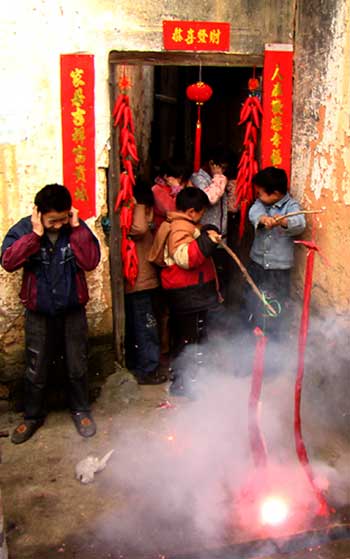
Boys setting off a string of firecrackers for Chinese New Year. Photo from chinaculture.org
鞭炮 Firecrackers: Traditionally, firecrackers are thought to scare away evil spirits. Their loud bangs have become a part of many joyous occasions in China.
春联 Spring Couplets: These pairs of red strips of paper decorated with black or gold Chinese characters expressing a family’s wish for the New Year are hung on either side of an entryway with a third red sign hung horizontally over the top of the door. Common wishes are for health, peace, safety, prosperity, success in business and school.
门神 Door Gods: Door gods, called ménshén are pairs of images traditionally affixed to outer doors to protect a family from evil spirits.福
Lucky Signs: A common decoration is a red, diamond-shaped sign containing the character “福” (fú) meaning happiness and good luck. This character is often hung upside-down as the Chinese word for “upside-down” sounds the same as “to arrive,” thus the meaning of the upside-down sign is that good luck and happiness has arrived or is going to arrive. Print and color your own fu sign below.
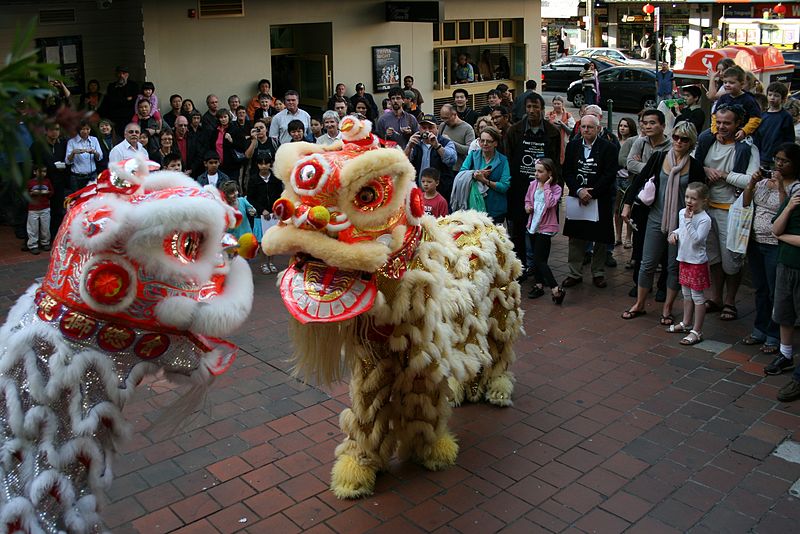
Chinese Lion Dancing outside Ashfield Mall during Ashfield’s Big Yum Cha, part of the Sydney International Food Festival. Photo by Toby Hudson
舞龙/舞狮 Dragon and Lion Dances: Dragon dances (wǔlóng) and lion dances (wǔshī) are common during Chinese New Year. It is believed that the loud beats of the drum and the deafening sounds of the cymbals together with the face of the dragon or lion dancing aggressively can scare away evil spirits. Lion dances generally involve 2 dancers who use martial arts techniques and acrobatics to perform the entertaining dance, while dragon dances usually require more performers to wield the large dragon puppet.
龙 Dragons: Dragons are believed to bring good luck. Their qualities include great power, dignity, fertility, and wisdom. They are a symbol associated with the emperor.
鱼 Fish: Images of a fish are a common sight at the time of the New Year as they represent abundance. In Mandarin, the words for “fish” and “surplus” are homophones. Compare: yú (鱼 – fish) and yú (余 – remainder; extra; surplus). A common New Year’s phrase is: Having more than enough each year -年年有余 – nián nián yǒu yú.
Festive Activities (back to top)
Lucky Sign – 福 – Good luck and happiness: Fu Sign
Chinese New Year Cards with pinyin: New Year Cards Pinyin
Chinese New Year Cards with pinyin and pronunciation guide: New Year Cards Guide
Mandarin phrases for Chinese New Year with pinyin: New Year Phrases with Pinyin
Mandarin phrases for Chinese New Year with pinyin and pronunciation guide: New Year Phrases with Guide
Recommended Books, CDs and DVDs (back to top)
Celebrating Chinese New Year by Diane Hoyt-Goldsmith and Lawrence Migdale
Lion Dancer: Ernie Wan’s Chinese New Year by Kate Waters and Martha Cooper
Sam and the Lucky Money by Karen Chinn, Cornelius Van Wright and Ying-Hwa Hu
A New Year’s Reunion: A Chinese Story by Li Qiong Yu and Zhu Chen Liang
The Dancing Dragon by Marcia K. Vaughan and Stanley Wong Hoo Foon
Cat and Rat: The Legend of the Chinese Zodiac by Ed Young
The Great Race: The Story of the Chinese Zodiac by Dawn Casey and Anne Wilson
Gongs and Drums of Celebrations CD (available at ChinaSprout.com)
Chinese New Year’s Music by Heart of the Dragon Ensemble
“New Year in Ping Wei” DVD (available at ChinaSprout.com)


